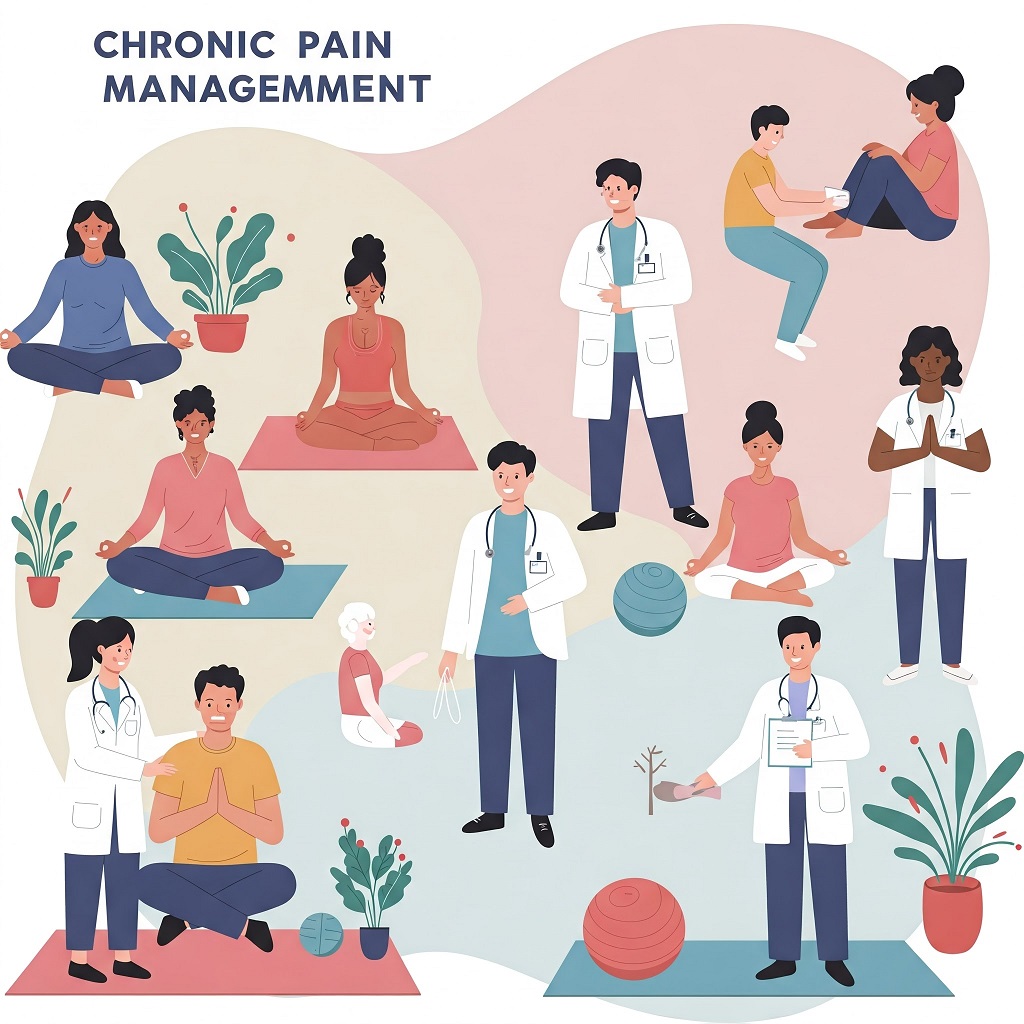Resilience Over Pain: Navigating Chronic Pain Management in Everyday Life
Introduction: Understanding Chronic Pain
Chronic pain is a long-lasting and often debilitating condition that can endure for extended durations, such as weeks, months, or even years. Unlike acute pain, which serves as a signal for injury or illness, chronic pain can persist well beyond the resolution of the initial issue. It impacts millions of individuals globally, disrupting everyday activities, mental well-being, and overall life satisfaction. Chronic pain may stem from various conditions, such as arthritis, nerve damage, fibromyalgia, and previous injuries. Effectively managing chronic pain necessitates a holistic approach that considers both physical and psychological elements.

Acute on chronic pain management is essential for individuals who experience sudden flare-ups of severe pain on top of their existing chronic condition. These episodes can be triggered by stress, overexertion, or worsening underlying health conditions. Therapeutic approaches typically incorporate a mix of drugs, physical rehabilitation, and lifestyle changes to manage both ongoing discomfort and sudden pain flare-ups. A tailored approach, including the use of non-opioid pain relievers, nerve blocks, or even cognitive behavioral therapy, can help manage these episodes without exacerbating the chronic pain condition.
Understanding chronic pain and its management requires ongoing education and proactive strategies. Patients benefit from working closely with healthcare providers to develop individualized treatment plans, including medication, exercise, diet modifications, and alternative therapies like acupuncture or meditation. Emotional health plays a vital role since long-term pain can result in feelings of depression and anxiety. By adopting a holistic strategy and staying informed about the latest pain management techniques, individuals suffering from chronic pain can improve their quality of life and regain a sense of control over their circumstances.
The Science Behind Chronic Pain
Human physiology is a frontier of endless complexity, with chronic pain revealing how intricate this system can be. Chronic pain involves new and dysfunctional nerve pathways, influencing neurotransmitter levels like serotonin and norepinephrine—integral players in pain perception and emotional regulation. When these pathways become exaggerated, they lead to central sensitization, where even minor stimuli trigger significant pain responses. Exploring recent advances in research reveals promising avenues in modulating these responses, guiding the future of pain management.
Vividly, new research shines a light on these mechanisms, allowing for the development of therapies designed to not only alleviate pain but also address its secondary effects like chronic fatigue, anxiety, and depression. For individuals suffering from chronic pain, an increased understanding of these processes empowers them to advocate for treatment options scientifically tailored to their unique neurological profiles.
Mindfulness Techniques for Pain Management
Mindfulness practices have emerged as a vital strategy in managing chronic pain by merging ancient wisdom with contemporary science. Research demonstrates that techniques such as meditation, yoga, and focused breathing can significantly alter the perception of pain. Through mindfulness, people can notice their thoughts and feelings without criticism, which can lessen the severity of their pain and lower the related emotional distress.
For instance, mindfulness meditation encourages practitioners to focus on their breath or bodily sensations, fostering a sense of presence that can rewire the brain’s response to pain signals. Similarly, yoga combines physical postures with mindfulness, promoting flexibility and strength while encouraging a deep connection between the mind and body. Focused breathing exercises also contribute to this practice by activating the body’s relaxation response, which counteracts the stress, often exacerbating pain.
Incorporating mindfulness into daily routines offers a powerful approach to bridging the mental and physical divide. Regular mindfulness practices help individuals develop greater emotional resilience and coping strategies, cultivating a holistic path toward personal healing. This comprehensive methodology eases physical discomfort and enhances overall well-being, empowering individuals to reclaim control over their lives and maintain a positive outlook despite chronic pain challenges.
The Role of Diet and Exercise
Nutrition and physical activity are fundamental to a comprehensive chronic pain management plan. Research highlights the benefits of anti-inflammatory diets, including various nutrient-dense foods such as fresh leafy greens, antioxidant-rich berries, fatty fish high in omega-3 fatty acids, and whole grains. These foods help decrease pain by reducing systemic inflammation, a frequent underlying cause of various chronic pain conditions.
In addition to making dietary modifications, regular physical activity is crucial for enhancing overall health and well-being. Exercise is a natural analgesic that promotes the release of endorphins, the body’s natural pain relief chemicals, while improving physical function and mobility. Implementing a personalized activity plan that considers one’s physical capabilities is essential, primarily when focusing on low-impact exercises. Swimming, tai chi, and Pilates are particularly beneficial, as they minimize joint stress while providing an effective workout.
The harmonious relationship between diet and exercise creates a holistic environment within the body. People can efficiently alleviate pain and its related symptoms by including anti-inflammatory foods and engaging in regular exercise. This dual approach fosters more balanced physiological processes and enhances psychological well-being, improving the quality of life for those managing chronic pain.
Technology’s Role in Pain Management
Emerging technologies are transforming chronic pain management, equipping patients and healthcare providers with innovative tools. Devices like smartwatches and fitness trackers facilitate ongoing tracking of important metrics, which aids in creating tailored care plans informed by real-time data. Telehealth has improved access to pain management specialists and holistic care approaches, overcoming geographical barriers. Patients can now connect with pain specialists through virtual consultations, gaining immediate knowledge and support.
Upcoming technological innovations encompass therapies using virtual reality, neurofeedback methods, and the incorporation of artificial intelligence (AI) to tailor treatments. Virtual reality therapies offer immersive experiences that help distract patients from pain or assist in desensitization processes. Neurofeedback provides real-time information about brain activity, enabling individuals to learn how to regulate their pain responses. The incorporation of AI facilitates the examination of large quantities of patient information to forecast how patients might react to different treatments. This can create a more empathetic and effective strategy for managing chronic pain, enhancing the comprehension of each patient’s experience.
Emotional Wellness and Support Systems
Emotional health is no longer considered a separate aspect of well-being; it is intricately woven into the fabric of chronic pain management. Emotional distress not only exacerbates the sensation of pain but also complicates the overall healing process. Therefore, prioritizing mental health is of utmost importance for individuals dealing with chronic pain.
Counseling services, cognitive-behavioral therapy, and peer support groups play vital roles in fostering emotional wellness and significantly enhancing a comprehensive pain management strategy. These services help individuals develop coping mechanisms, challenge negative thought patterns, and cultivate resilience in persistent discomfort.
Moreover, building a robust network of support—comprising family, friends, and peers who truly understand the unique challenges associated with chronic pain—serves as a protective buffer against emotional lows. Engaging in conversations and sharing experiences in safe, empathetic environments can help dispel feelings of isolation, reinforcing that strength is often found through shared understanding and solidarity. This shared support not only helps in the process of emotional recovery but also cultivates a feeling of community and connection among individuals dealing with the challenges of chronic pain.
Future Directions in Pain Management
Chronic pain management is rising with innovative treatments and improved patient outcomes. Gene therapies like CRISPR are being explored to target and modify genetic mutations contributing to chronic pain. In contrast, regenerative medicine techniques like stem cell therapy and tissue engineering repair damaged tissues and promote healing. Artificial intelligence and large-scale data analysis are revolutionizing treatment approaches by analyzing patient data to create personalized treatment plans. This shift towards precision medicine allows practitioners to select interventions with fewer side effects and more effectiveness. As these innovations evolve, they promise to transform chronic pain management, providing hope for patients seeking relief from persistent pain. With ongoing research and clinical trials, breakthroughs may lead to pain eradication and a new era of care for those affected by chronic pain.
Conclusion: Empowering Yourself Against Pain
Chronic pain is a multifaceted challenge that necessitates a comprehensive strategy. It encompasses mindfulness techniques, dietary modifications, and consistent physical activity. Practicing mindfulness can alleviate stress and enhance pain control. Substances like omega-3 fatty acids and antioxidants could help with pain relief. Engaging in exercises like swimming or yoga promotes physical strength and flexibility. Innovations in technology, including wearable gadgets and meditation applications, can aid in alleviating symptoms. Support from loved ones, friends, or social networks can foster a sense of belonging and reduce feelings of isolation. With a thorough understanding of their situation and access to these resources, individuals experiencing chronic pain can navigate their daily lives with renewed resolve, leading to a life rich in possibility, purpose, and empowerment.












